In this tutorial, I'll show you exactly how I create botanical gelli prints, using leaves and flowers I pressed last summer.
I love keeping a big collection of dried plants to work with during the winter months—it means I can still make botanical prints even when there's nothing fresh to pick from the garden.
To create these prints, I'm using acrylic paint and an assortment of paper from typewritten pages to sketch paper I've stained with coffee. They'll add a lovely, layered element to my paintings and collages.
Follow along with me and I’ll show you exactly how they're made!
Watch the full video tutorial here:
Materials You’ll Need
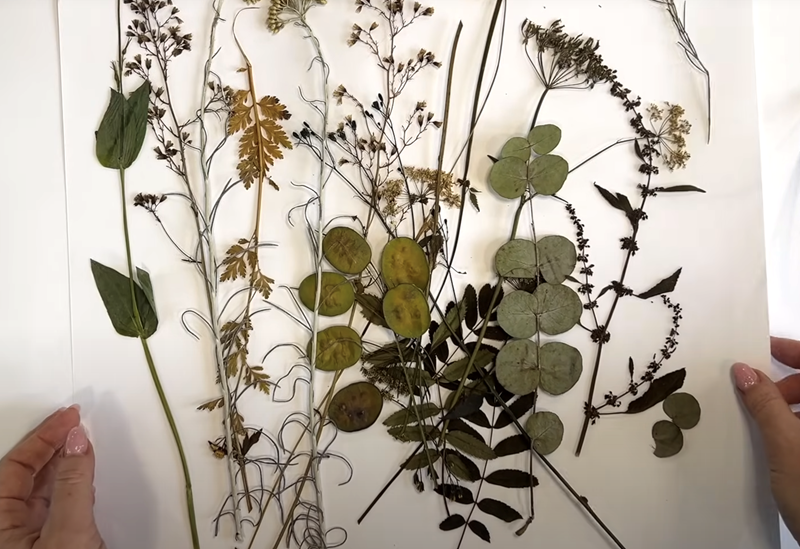
Dried Leaves and Flowers
These are a few of the flowers and leaves I pressed and stored last summer. I have a variety of shapes and sizes including some leafy stems and some small and large flowering plants.
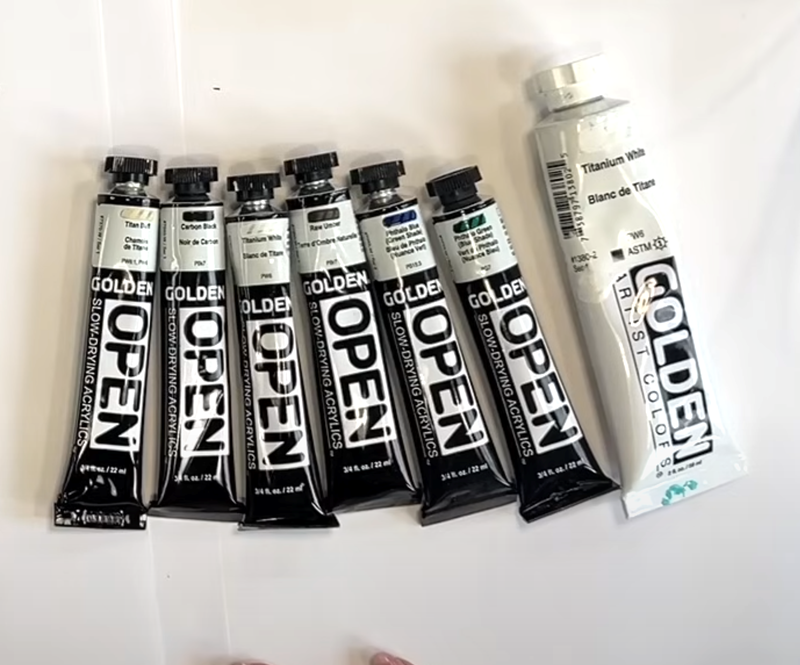
Paint
In this tutorial, I’m using Golden’s Open Acrylics, which I recently picked up after hearing other gel print artists recommending them. Open Acrylics give you a longer working time to pull your prints and are brilliant for picking up fine details.
I'll be using Open Acrylics in Titan Buff, Carbon Black, Titanium White, Raw Umber, Phthalo Green (Green Shade), and Phthalo Green (Blue Shade).
I found that the Open Titanium White is slightly less opaque and blends a bit differently than a traditional heavy body Titanium White, so I’ve got some of that on hand as well.
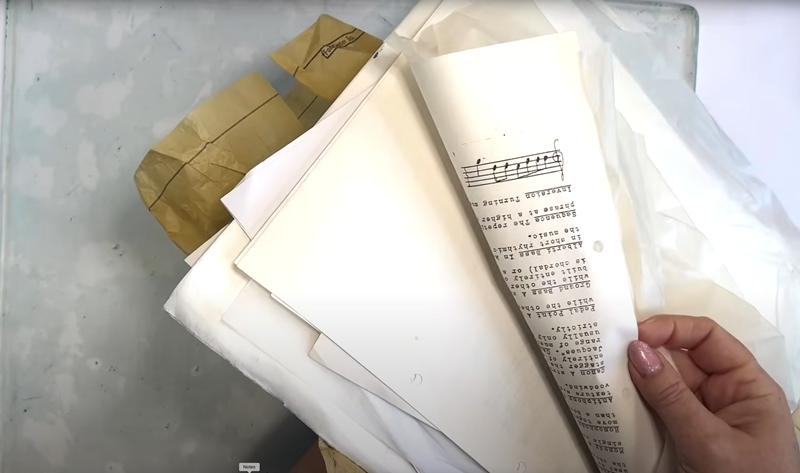
Paper Selection
To get a nice variety of effects, I’ll be using all sorts of papers, including mixed media paper, typewritten copy paper, sheet music, and existing prints.
I’ve also used some lovely transparent wet strength tissue papers like Maruishi and Abaca paper. For a soft antiqued tone, I’ve dyed some sketch paper with coffee, and I’ve even saved a few of the papers I've used to clean off my brayer between prints.
Each type of paper brings its own unique texture and character to the final piece!
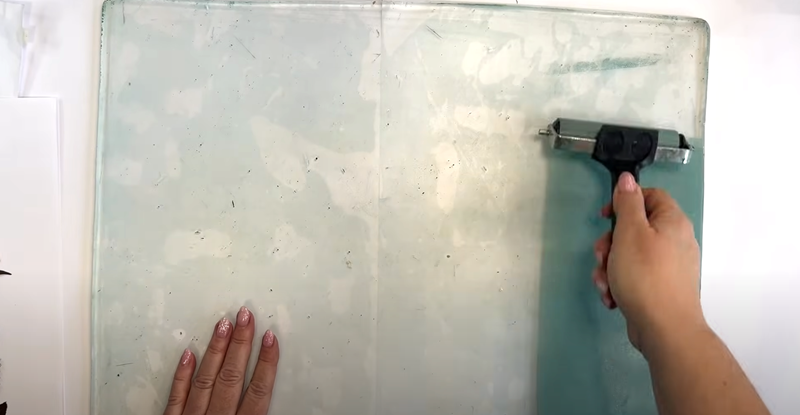
Gel Plate
I’m working with my 16 x 20 Gelli plate. While you can certainly do these techniques on a smaller plate, I find the larger surface area gives me more flexibility for creating both small and large prints.
You’ll also need a rubber roller, called a brayer, to spread the paint. I like to keep two brayers on hand: one for rolling the paint, and a clean one for rolling over the paper to ensure good contact between the paint and paper. I also use a round printmaking tool called a baren, which is gentler on delicate papers than the brayer.
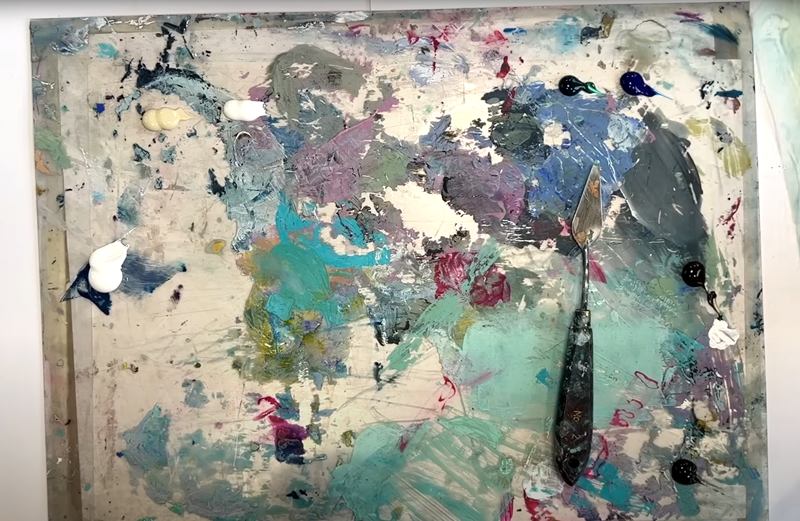
Tools
You’ll need a palette knife and a palette for mixing your paint. For my palette, I like to use a sturdy piece of cardboard with a sheet of white paper taped on it (so I can see the colours properly), topped with a piece of perspex/plexiglass.
It doesn’t matter if it has a bit of dried paint on it from previous sessions.
Mixing the Paint
I’m going for a soft, blue-green palette for these prints. While you can use paint straight from the tube, I’ll show you how I custom blend the colours to get just the look I’m after.
I begin by putting a little paint on the palette, keeping the darker colours to one side.
Blue-Green
These Golden paints have a lot of pigment, so a little goes a long way. I’m going to start with Titan Buff, mixed with just a touch of Pthalo Green (blue shade). I’ll then add a tiny bit of Raw Umber and Titanium White. I use my palette knife to blend them together until I get a soft blue-green, somewhere between a duck egg blue and an olive green.
Teal
Next I'll pull a bit of the blue-green colour I just created on my palette knife, and blend in a bit of Raw Umber. I follow that with Titan Buff. After I blend together with the palette knife, I add a touch of Pthalo Green (green shade) and blend well. Finally, I blend in a bit of Pthalo Green (blue shade), and enough Titanium White to create a lovely teal.
Soft Green
With the residual teal still on my palette knife, I pick up a bit of Raw Umber and blend it well. Then I mix in some Titanium White and blend it all together well to create a soft green.
Tip: Put some paint swatches on a piece of copy paper to make sure you’re happy with how the colours look together.
Creating The Prints
Now that we’ve got our paints sorted, it’s time to start printing!
I’m starting with my soft green, applying a small amount on the side of the plate and rolling it out with my brayer in smooth, long strokes to create an even layer.
Tip: For the best results, lift the brayer off the plate at the end of each stroke, rather than rolling back and forth like you would if painting a wall.
Next, I place a pressed plant onto the gel plate and then lay a piece of my coffee-stained, sketchbook paper over it.
I follow the coffee-stained paper with a clean sheet of copy paper, smoothing it down with my hands to make sure there's good contact between the paper and the paint.
Using a clean, dry brayer, I gently roll over the plant to ensure it’s fully pressed down.
Finally, I carefully peel away the paper to reveal the print!
Next, I carefully remove the plant material so I can pull my “ghost prints” – those second (and sometimes third) prints made with the residual paint left on the gel plate.
Tip: You might notice little bits of dried leaves stuck to the plate, but these can easily be removed with a pair of tweezers.
I’ll try pulling the ghost prints with a light-coloured paper, like this white sketchbook paper.
I repeat the process, but this time with teal paint. For this print, I’m using a dried, pressed flower and a couple of pieces of curry plant.
I apply a piece of Maruishi wet-strength tissue paper over top, lightly pressing it with my hand to smooth it out. I follow this with a piece of copy paper, again smoothing it out with my hand to ensure the plants are flat, before rolling it out with my clean brayer.
Now, I’m combining my soft blue-green paint with a selection of small leafy stems and plants with delicate flowers and a larger piece of coffee-stained paper.
After smoothing it out with my hand, I roll my clean brayer over it to ensure the paint makes good contact with the paper.
Once that’s done, I carefully pull the paper back to reveal the print - gorgeous!
There's still a little black paint left on the gelli plate, so I pull it onto another print.
Next, I pull the ghost print over the typed paper I used under the brayer while I was printing earlier.
I love how the black contrasts with the blue behind the text, and the white area in the middle adds a lovely touch. Absolutely gorgeous!
My Results
All in all, I spent about an hour and a half printing these botanicals, and it turned out to be a really lovely session. Each print turned out a little different, with an effect you just can’t get with a paintbrush—that’s what I love most about using the gelli plate!
Coffee-Dyed Papers:
They have such a soft, antique look, and I love how the coffee stain even peeks through the silhouettes.
Transparent Papers:
The wet-strength tissue papers like Maruishi and Abaca may not be great on their own, but they’re brilliant for layering over bolder patterns or typewritten paper.
Once you apply glue on top, the tissue becomes transparent, creating little ‘windows’ that let you see what’s happening underneath.
Brayer Cleaning Paper:
I keep the sheets of paper I used for cleaning my roller in between prints. It creates a lovely, graphic element with pops of white and subtle colour changes underneath.
I layered these pieces with different parts of the gel plate. I absolutely love the silhouette with the black outline, with the white and pink tones peeking through.
Typed Pages:
You can use typewriter pages, sheet music, or even pages pulled from old books. They provide a great element of interest and are brilliant for layering underneath transparent paper.
I'm so pleased with the typewritten page with the teal edges and black botanical prints - I think it's my favourite one from this whole session!
I’m really happy with the results of that printing session. I have a really nice collection of papers, all in different tonal values that I can use in future paintings and collages.
I hope you enjoyed the tutorial and picked up some tips. Remember, you just need to give yourself the chance to build up an inventory of prints - and permission to experiment! It’s amazing what you can create once you get going.
If you’d like to learn more, sign up to my newsletter so you never miss a new tutorial. I also offer a FREE course called "The Essence of Landscape", where I teach how to turn your prints into finished paintings.
Happy printing!


































































































